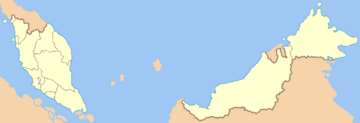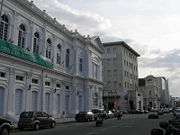George Town, Penang
| George Town Tanjung |
|
 |
|
| Motto: "Leading We Serve" | |
 George Town
|
|
| Coordinates: | |
| Country | |
|---|---|
| State | Penang |
| Founded | 1786 |
| Municipality established | 1857 |
| Granted city status | 1957 (merged in 1974) |
| Area | |
| - City | estimated 150 km² (58.59 sq mi) |
| Elevation | 4 m (13.1 ft) |
| Population (2006) | |
| - City | 300,000(33rd) |
| - Density | est 1,464/km² (3,748/sq mi) |
| - Metro | 1,225,501 |
| (metro pop is a 2000 est) | |
| Time zone | MST (UTC+8) |
| - Summer (DST) | Not observed (UTC) |
George Town is the capital city of the state of Penang in Malaysia. Named after Britain's King George III, the city is located on the north-east corner of Penang Island and has about 220,000 inhabitants, or about 400,000 including the suburbs.
George Town was founded in 1786 by Captain Francis Light, a trader for the British East India Company, as base for the company in the Malay States. He obtained the island of Penang from the Sultan of Kedah and built Fort Cornwallis on the north-eastern corner of the island. The fort became the nexus of a growing trading post and the island's population reached 12,000 by 1804.
George Town is informally known simply as Tanjung ("The Cape") in Malay and 喬治市 (Qiáozhì Shì) in Chinese. It was voted as one of the best cities in Asia by Asiaweek, ranked 6th in 1998 and 9th in 2000. More recently in 2007, it was ranked as the 10th most liveable city in Asia according to an international survey involving 254 cities worldwide by Conditions Abroad Limited (ECA International). Back in 2002, it was placed 12th. A city is judged based on its weather, air quality, infrastructure, health services, housing, security and politics.
Due to strict rent controls, George Town retains many colonial-era shophouses to this day and is often considered an architectural gem. Most of George Town's population is of Chinese origin.
Since the repeal of the rent controls in 2000, many pre-war buildings have given way to new high rises. Heritage guidelines are still in its infancy and much needs to be done to conserve such treasures for the benefit of future generations.
On 7 July 2008, George Town, the historic capital of Penang was formally inscribed as a UNESCO World Heritage Site alongside with Malacca. It is officially recognized as having a unique architectural and cultural townscape without parallel anywhere in East and Southeast Asia.[1]
Contents |
History
| Melaka and George Town, Historic Cities of the Straits of Malacca* | |
|---|---|
| UNESCO World Heritage Site | |
| State Party | |
| Type | Cultural |
| Criteria | ii, iii, iv |
| Reference | 1223 |
| Region** | Asia-Pacific |
| Inscription history | |
| Inscription | 2008 (32nd Session) |
| * Name as inscribed on World Heritage List. ** Region as classified by UNESCO. |
|

George Town was built on swampy land that had to be cleared of vegetation, levelled and filled. The original commercial town was laid out between Light Street, Beach Street (then running close to the seashore), Malabar Street (subsequently called Chulia Street) and Pitt Street (now called Masjid Kapitan Keling Street).
The warehouses and godowns extended from Beach Street to the sea. By the 1880’s, there were ghauts leading from Beach Street to the wharf and jetties as Beach Street receded inland due to land reclamation. A new waterfront was created at Weld Quay, where commercial buildings sprang up.
The historic commercial centre was segmented into the banking and trading areas related to port activities which included shipping companies, the import and export trade, and the wholesalers who dominate the southern section of Beach Street until now. It has been listed as a World Heritage site since July 2008.[1]
The hub of George Town’s waterfront commercial and financial district
At the turn of the 19th century, the northern section of Beach Street and the adjacent Bishop Street were the ‘high street’ where the ‘modern’ European emporium and stores selling imported merchandise were situated.
Among the early foreign companies that located their offices on Beach Street were the Netherlands Trading Society, the Hongkong & Shanghai Banking Corporation (HSBC), the Chartered Bank, Boustead & Co., Guthne & Co., Caldbeck & Macgregor, Behn Meyer, Sandilands & Buttery, G.H. Slot and the stores of Pritchard & Co., Whiteaway, Laidlaw & Co., and others. Among the local businesses that were established here during this period were H.M. Nooradin, Tiang Lee & Co., Guan Lee Hin Steamship, Tye Sin Tat, Pinang Sales Room, Koe Guan and others. Penang’s first petroleum lamps were installed on this section of Beach Street by Huttenbach & Co..
Local Government
Future development
On 2 August 2006, the federal government announced a plan to build a monorail urban transit system connecting George Town to Tanjung Tokong in the north and Bayan Lepas in the south. However, due to the defeat in Penang of the Barisan Nasional coalition after the 2008 General Election, the proposed development project was called-off after the mid-term review of the Ninth Malaysia Plan which was tabled in Parliament on June 26, 2008.
Gallery
Sister cities
See also
- Cities of Malaysia
- Architecture of Penang
- City Hall, Penang
References
- ↑ "Eight new sites, from the Straits of Malacca, to Papua New Guinea and San Marino, added to UNESCO’s World Heritage List", UNESCO (2008-07-07). Retrieved on 2008-07-07.
Literature
- Khoo Salma Nasution. More Than Merchants: A History of the German-speaking Community in Penang, 1800s-1940s. Areca Books. (2006). ISBN 978-9834283414
External links
 Media related to George Town, Penang at Wikimedia Commons
Media related to George Town, Penang at Wikimedia Commons- Georgetown travel guide from Wikitravel
- Georgetown Community Portal
- Article about Georgetown
- Trails of Georgetown
- The Northam All Suite Penang
|
|||||||||||||||||
|
||||||||||||||
|
|||||